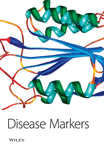Crosstalk between Activated and Inactivated c-Src in Hepatocellular Carcinoma
Abstract
C-Src activity is regulated by tyrosine phosphorylation at two distinct sites, Tyr416 and Tyr527, with opposite effects. However, the clinical roles of these sites in human cancers are not well defined. This study aims to determine whether the alterations and crosstalk of these two sites may contribute to hepatocellular carcinoma (HCC). Specimens from 85 patients who had undergone curative hepatectomy were collected for this study. The patterns of p-Tyr416-Src and p-Tyr527-Src, as well as the non-phosphorylated status for each site, were determined using immunohistochemistry and statistically correlated with clinicopathological characteristics and overall survival rate. The active state of c-Src, p-Tyr416-c-Src, was positively correlated with tumour grade (P = 0.062) but inversely correlated with vascular invasion (P = 0.071). Its non-phosphorylated status, non-p-Tyr416-c-Src, was positively correlated with tumour stage and grade (P = 0.041 and 0.020). The inactive state of c-Src, p-Tyr527-c-Src, was decreased in male patients but increased HCV-infected patients (P = 0.044 and 0.033). The Kaplan-Meier survival curve further showed that increased p-Tyr416-c-Src and decreased non-p-Tyr527-c-Src expression were associated with a poor patient survival rate (P = 0.004 and 0.025). Interestingly, the expression of non-p-Tyr416-c-Src was positively correlated with that of p-Tyr527-c-Src in the HCC lesions (P = 0.040). In addition, the patients with concomitantly low p-Tyr416-c-Src and non-p-Tyr527-c-Src expression had a prolonged overall survival rate (P = 0.030). A multivariable COX regression model showed that p-Tyr416-c-Src expression was an effective predictor for patient survival in HCC [OR = 3.78, 95%CI = 1.46–9.76; P = 0.006]. Our results suggest that the active state of c-Src, p-Tyr416-c-Src, may serve as an independent prognostic marker of patient survival in HCC. Relative levels of other phosphorylated or non-phosphorylated c-Src kinases may also present different statuses during HCC development and require further investigation.




